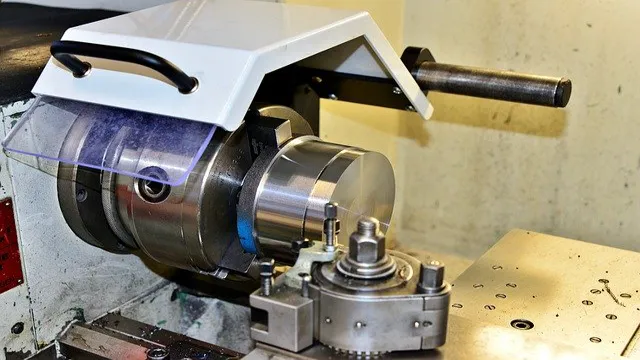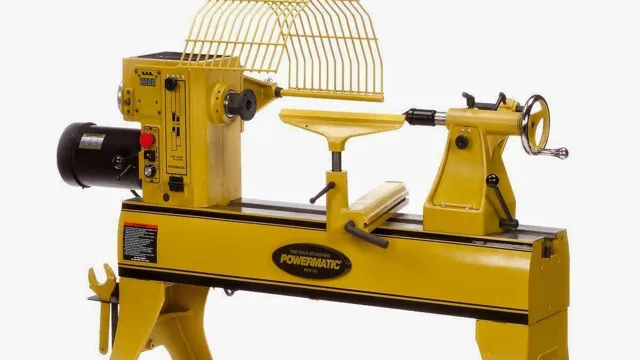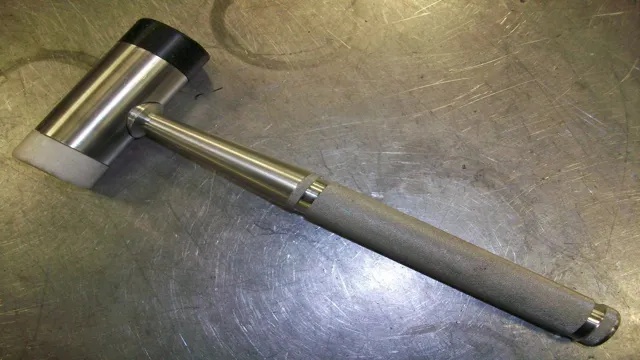What Does a Metal Lathe Do? A Comprehensive Guide to Working With Metal.

Metalworking can be a fun and fulfilling hobby, but if you truly want to step up your game, you might want to invest in a metal lathe. So, what exactly is a metal lathe? Simply put, it is a tool used in metalworking that rotates a workpiece on its axis, allowing you to perform various operations such as cutting, drilling, and sanding. Think of a metal lathe as a potter’s wheel, but instead of clay, you’re working with metal.
With the right skills and knowledge, a metal lathe can create precise pieces for your DIY projects, or even help you create customized parts for your machinery. A metal lathe might seem daunting at first, but with proper training and safety precautions, anyone can learn to use it effectively and unleash their creativity. Whether you want to restore an old car or build a custom bike, a metal lathe can help you achieve your goals and take your metalworking skills to the next level.
So why not give it a shot and see what you can create with this versatile tool?
Overview of Metal Lathes
Metal lathes are an essential tool for anyone looking to craft, shape, or refine metal surfaces. Essentially, a metal lathe is a machine that rotates a piece of metal at a high speed while a cutting tool is used to remove excess material. The end result is that the metal is transformed into the desired shape or form.
Whether you’re looking to create a part for machinery or simply want to create a unique piece of metalwork, a metal lathe is the tool you need to get the job done. By using a variety of tools and techniques, you can manipulate metal in a way that would be impossible through manual labor alone. No matter what your level of experience or the complexity of your project, a metal lathe is an indispensable tool that can help you achieve your goals.
History of Metal Lathes
Metal lathes have been an essential machine tool in manufacturing for centuries. They were first used in ancient Egypt and were powered by hand. In the 19th century, metal lathes began to be powered by steam engines and gas engines.
This innovation made it easier to manufacture precision metal parts, which revolutionized many industries. Metal lathes can now be powered by electricity and computer systems, making it possible to create intricate parts with high precision. Today, metal lathes are widely used in various industries, including aerospace, automotive, and medical equipment manufacturing.
If you are looking to purchase a metal lathe, make sure to consider the different types available, such as a CNC lathe or a manual lathe, to ensure that you get the best tool for your needs.

Types of Metal Lathes
Metal lathes are an essential tool for metalworking enthusiasts, machinists, and professionals alike. They are used to rotate an object along its axis while cutting, drilling, or shaping it with precision and accuracy. There are several types of metal lathes available on the market, each with unique features, advantages, and disadvantages.
The most common metal lathes are benchtop or mini-lathes, engine lathes, and turret lathes. Benchtop or mini-lathes are small and compact, suitable for hobbyists and DIY enthusiasts, while engine lathes are larger and more robust, designed for industrial use and heavy-duty machining tasks. Turret lathes, on the other hand, are automated machines that can operate with minimal human intervention, making them ideal for mass production.
No matter the type of metal lathe you use, be sure to choose one that fits your needs, budget, and skill level. With proper use and maintenance, metal lathes can last for decades and provide consistent and reliable performance.
How does a Metal Lathe work?
A metal lathe is a machine tool that is used to shape and cut metal to produce precise and accurate parts. It works by rotating a piece of metal on a spindle while a cutting tool removes material from the metal. The cutting tool is positioned on a tool slide, which moves along the length of the metal as it rotates.
This allows the cutting tool to remove material from the metal at various depths and angles. The cutting tool can also be adjusted to produce different shapes and sizes, depending on the needs of the project. Metal lathes can be used to create a wide range of products, including bolts, screws, gears, and engine parts.
They are commonly used in manufacturing and metalworking industries, and are important for creating parts with high precision and accuracy. Overall, metal lathes play a crucial role in the production of various metal parts and components, making them an invaluable tool in the manufacturing process.
Components of a Metal Lathe
A metal lathe is a vital tool in any machine shop, capable of shaping and cutting metal workpieces with a high degree of precision. The metal lathe works by rotating the workpiece on an axis while a cutting tool is pressed against it. As the workpiece rotates, the cutting tool removes material from it, producing a precise shape.
The key components of a lathe include the bed, headstock, tailstock, and carriage, which work together to support and move the workpiece and the cutting tool. The bed is the foundation of the lathe, providing a stable platform for the other components, while the headstock holds the workpiece and provides the rotational motion. The tailstock supports the other end of the workpiece and provides additional stability.
The carriage moves the cutting tool along the length of the workpiece and controls the depth of the cuts. Understanding how a metal lathe works and its components is essential for any aspiring machinist or engineer.
Operations of a Metal Lathe
If you’ve ever seen a metal lathe in action, you might have been fascinated by how perfectly it can shape and cut metal pieces. But how does it work? The metal lathe uses a spinning chuck to hold the metal workpiece in place. As the chuck rotates, a cutting tool is brought closer to the metal surface, slowly removing layers of material until the desired shape is achieved.
The cutting tool can be adjusted to cut at different depths and angles, allowing for precise cuts and intricate designs. One of the keys to successful lathe operations is ensuring that the cutting tool is sharp and properly aligned with the workpiece. Additionally, controlling the speed of the chuck and the cutting tool is crucial for achieving the desired results.
Whether you’re crafting a custom metal part or simply curious about how a metal lathe functions, this versatile tool is a marvel of precision engineering.
Applications of a Metal Lathe
A metal lathe is a versatile machine that can be used for a wide range of applications in the manufacturing industry. The basic function of a metal lathe is to turn a piece of metal and shape it into the desired form using a cutting tool. The machine operates by rotating the metal workpiece on its axis, while a set of cutting tools move along the length of the piece to make precise cuts.
The cutting tools are designed to fit into a tool post, which is mounted on the lathe bed. The operator can adjust the tool post to control the depth and angle of the cut, creating a wide variety of shapes and surfaces on the metal workpiece. Some of the typical applications of a metal lathe include cutting threads, turning cylindrical shapes, and boring holes in metal materials.
With its precision and versatility, a metal lathe is an essential tool for any machine shop or manufacturing facility.
Benefits of Using a Metal Lathe
Metal lathes are versatile machines that are used to shape and cut metal into a variety of forms. They are commonly used in metalworking shops for turning, drilling, and milling operations on metal pieces, allowing for precise and accurate cuts. One of the benefits of using a metal lathe is that it can produce highly polished and intricate designs on metal, giving it an attractive and professional appearance.
Additionally, they are incredibly durable and can withstand heavy-duty use for extended periods, requiring minimal maintenance. Metal lathes also provide greater efficiency and productivity in metalworking shops, enabling workers to complete projects more quickly and accurately. With its multiple features and capabilities, a metal lathe is an essential tool for any metalworking professional and hobbyist alike.
Precision Machining
Precision machining is a process that involves shaping a metal workpiece to very exact specifications. One of the most useful and versatile machines for precision machining is the metal lathe. There are many benefits to using a metal lathe in precision machining.
First and foremost, a metal lathe provides excellent precision and accuracy, which is essential for creating intricate parts and components. Additionally, a lathe can be used for a wide range of materials, including metal, plastic, and wood. This versatility makes a lathe a valuable tool for businesses that work with a variety of materials.
Another benefit of using a metal lathe in precision machining is that it can save time and increase productivity. By automating certain tasks, a lathe can reduce labor costs and free up workers for other tasks. Finally, a metal lathe is a durable and long-lasting machine that can withstand heavy use.
This makes it a reliable investment for any business that needs precise and consistent results in their machining operations. Overall, a metal lathe is an invaluable tool for precision machining, offering numerous benefits that can help businesses save time, lower costs, and improve the quality of their products.
Versatility
One of the most significant benefits of using a metal lathe is its versatility. It is an incredibly useful machine that can produce a wide range of metal parts and components for various applications. Depending on the project requirements, a metal lathe can be used to cut threads, drill holes, shape, and polish metal surfaces.
The machine’s versatility is due to its multifunctional capabilities, which allow it to perform various operations with ease. In addition, modern metal lathes are designed with advanced features and technology that enable operators to achieve precision and accuracy in their work. Therefore, if you are looking for a machine that can help you produce high-quality metal parts and components with ease, a metal lathe is an excellent choice.
Its versatility allows you to complete complex projects quickly and efficiently, making it a valuable addition to any metalworking shop.
Conclusion
In short, a metal lathe is like a master craftsman’s assistant, patiently spinning and shaping metal into precision-crafted works of art. It’s the ultimate tool for those obsessed with perfection, allowing them to turn their visions into reality with unmatched accuracy and finesse. So, if you’re looking to make your mark in the world of metalworking, a metal lathe is the tool you need in your arsenal.
Who knows, with a little practice and ingenuity, you might just carve out a new path towards greatness in the world of metalworking!”
FAQs
What is a metal lathe used for?
A metal lathe is used to shape and finish metal objects with precision and accuracy.
How does a metal lathe work?
A metal lathe works by rotating a metal workpiece while a cutting tool removes material to shape and finish the object.
What safety precautions should be taken when using a metal lathe?
When using a metal lathe, it is important to wear eye protection, secure loose clothing and jewelry, and use caution when handling sharp tools and hot metal.
How do you maintain a metal lathe?
To maintain a metal lathe, it is important to keep it clean, lubricated, and properly adjusted. Regular cleaning and oiling can prevent damage and prolong the life of the machine.
Can a metal lathe be used for other materials besides metal?
While a metal lathe is primarily used for metalworking, it can also be used on other materials like wood, plastics, and some composites.
What are some common types of metal lathes?
Some common types of metal lathes include engine lathes, bench lathes, turret lathes, and CNC lathes.
What are some common projects that can be done on a metal lathe?
Some common projects that can be done on a metal lathe include turning, drilling, threading, and knurling on metal objects like bolts, shafts, and gears.



